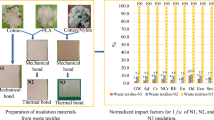Abstract
Insulation of buildings in order to save heating energy is an important technology for enabling sustainable development. This paper summarises the results of a comparative LCA study according to ISO 14040 standard series of HT stone wool, flax representing crop grown products and paper wool representing recycled products applied for roof insulation. As the three materials have vastly different lifecycles, yet fulfil the same function cycles, the methodology used should be of general interest. Part 1 consists of the project background, goal and scope definition, a detailed life cycle inventory analysis with sensitivity analysis, impact assessment and interpretation. The actual comparison of the results from the life cycle assessments of the three products, in which an attempt is made to answer the question of whether the biological products flax and paper wool are more environmentally preferable than the mineral product stone wool representing more traditional insulation materials, is discussed in Part 2.
Similar content being viewed by others
References
Commission of the European Communities, (2001): Commission Staff Working Paper Third Communication from the European Community under the UN Framework Convention on Climate Change. Brussels, 30 November 2001. http://europa.eu.int/comm/environment/climat/ official sec 2001 2053 en.pdf
Rockwool International A/S (1996): B0rsintroduktion (Stock Market Introduction)
Stranddorf HK, Schmidt A, Hansen LE, Jensen AA, Thorsen M (1995): Thermal Insulation Products for Walls and Roofs. Impact Assessment and Criteria for Ecolabelling. Draft for the Danish EPA. S0borg: dk-TEKNIK
Stranddorf HK, Hansen LE, Schmidt A et al. (1995): Establishing of key features (and criteria) covering the full life cycle for thermal insulation products for walls and roofs based on a LCA. Søborg: dk-TEKNIK
Bowdidge J (1998): Life cycle inventory assessment for Rockwool Limited for 1996. Rollbatts loft insulation thickness 150 mm. Pencoed, Bridgend, UK: Rockwool Limited (Unpublished)
Krogh H, Rasmussen JO, Nielsen PA (2001): Miljøvurdering af isoleringsmetoder. By og Byg Dokumentation 012. Hørsholm: Statens Byggeforskningsinstitut
CEPMC (2000): Guidance for the provision of environmental information on construction products. Brussels:Council for European Producers of Materials for Construction
Weidema B (2001): Market information in life cycle assessments. Technical report (final draft) from the Danish LCA-methodology development and consensus project, Subproject 2. Danish Environmental Protection Agency (to be published)
Frees N, Weidema BP (1998): Life cycle assessment of packaging systems for beer and soft drinks. Energy and transport scenarios. Technical report 7. Miljøprojekt nr. 406. Copen hagen: Miljøstyrelsen
Boustead I (2001): Eco-profiles of the European Plastics Industry. Polyethylene Terephthalate. A report for the European Centre for Plastics in the Environment. Brussels: APME
Boustead I (1997): Eco-profiles of the European Plastics Industry. Report 10: Polymer conversion. Brussels: APME
Boustead I (1998): Eco-profiles of the European Plastics Industry. Report 6: Polyvinyl chloride. Brussels: APME
BUWAL (1996): Ökoinventare für Verpacknungen. Schrif-tenreihe Umwelt Nr. 250/1. Bern: Bundesamt für Umwelt, Wald und Landschaft
BUWAL (1994): Vergleichende okologische Bewertung von Anstrichstoffen im Baubericht. Schriftenreihe Umwelt Nr. 232. Bern: Bundesamt für Umwelt, Wald und Landschaft
IVAM LCA Data 3.0 (2000). IVAM Environmental Research, University of Amsterdam
Guinée J (ed) (2001): Life cycle assessment. An operational guide to the ISO standards. Final report. Leiden: CML
Hauschild M, Wenzel H (1998): Environmental assessment of products. Volume 2: Scientific background. London: Chapman & Hall
Eco-Profile of hydrogen peroxide. Brussels: CEFIC. (http://www.cefic.be/sector/peroxy/ecohvdro/tc.htm
Rio Tinto Borax (2002): Optibor® Data sheet. Draft, November 2002
Rio Tinto Borax (2002): Borax Data Sheet. Draft, November 2002
BioMat NET (2000): Flax an
Author information
Authors and Affiliations
Corresponding author
Rights and permissions
About this article
Cite this article
Schmidt, A.C., Jensen, A.A., Clausen, A.U. et al. A comparative Life Cycle assessment of building insulation products made of stone wool, paper wool and flax. Int J LCA 9, 53–66 (2004). https://doi.org/10.1007/BF02978536
Received:
Accepted:
Issue Date:
DOI: https://doi.org/10.1007/BF02978536




